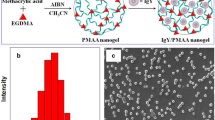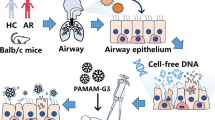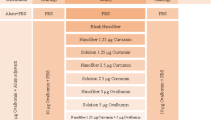Abstract
The derailed nasal epithelial barrier is associated with the disorder of tight junctions (TJ) function or expression, leading to more penetration of allergens to the barrier, accompanied by the release of cytokines, which develop allergic rhinitis (AR). Considering the increasing AR disease incidence worldwide, there is still an urgent unmet medical need to develop new therapeutics. Tumor necrosis factor-alpha (TNF-α) inhibitors have been applied in treating autoimmune diseases. However, their roles in AR remain unclear. In this study, anti-TNF-α nanobody (V) was assembled with tannic acid (V/TA) as a functional antibody drug candidate which could inhibit the release of the cytokines in ovalbumin (OVA)-induced AR murine model. Upon receiving V/TA treatment, the infiltration level of inflammatory cells, and the number of mucus-secreting cells and mast cells in the nasal mucosa recovered to a relatively normal level. Preliminary mechanism of action research revealed that the efficacy of V/TA was accompanied by the restricted level of TJ molecules: zonula occluden-1 (ZO-1), occludin, claudin-1, and claudin-5. The therapeutic effect of the anti-TNF-α nanobody against AR was enhanced with the tannic acid assisted without any toxicity observed. This study supplied a promising delivery strategy of TNF-α inhibitor for the effective treatment of complicated allergic rhinitis disease, with an advantage in restoring effect on the AR-caused epithelial barrier defects than the commercial drug Infliximab.

Similar content being viewed by others
References
Okubo, K.; Kurono, Y.; Ichimura, K.; Enomoto, T.; Okamoto, Y.; Kawauchi, H.; Suzaki, H.; Fujieda, S.; Masuyama, K. The Japanese Society of Allergology. Japanese guidelines for allergic rhinitis 2020. Allergol. Int. 2020, 69, 331–345.
Wheatley, L. M.; Togias, A. Allergic rhinitis. N. Engl. J. Med. 2015, 372, 456–463.
Kanagaratham, C.; El Ansari, Y. S.; Sallis, B. F.; Hollister, B. M. A.; Lewis, O. L.; Minnicozzi, S. C.; Oyoshi, M. K.; Rosen, R.; Nurko, S.; Fiebiger, E. et al. Omeprazole inhibits IgE-mediated mast cell activation and allergic inflammation induced by ingested allergen in mice. J. Allergy Clin. Immunol. 2020, 146, 884–893.e5.
Meng, Y. F.; Wang, C. S.; Zhang, L. Advances and novel developments in allergic rhinitis. Allergy 2020, 75, 3069–3076.
Zhang, Y.; Lan, F.; Zhang, L. Advances and highlights in allergic rhinitis. Allergy 2021, 76, 3383–3389.
Steelant, B.; Farré, R.; Wawrzyniak, P.; Belmans, J.; Dekimpe, E.; Vanheel, H.; Van Gerven, L.; Kortekaas Krohn, I.; Bullens, D. M. A.; Ceuppens, J. L. et al. Impaired barrier function in patients with house dust mite-induced allergic rhinitis is accompanied by decreased occludin and zonula occludens-1 expression. J. Allergy Clin. Immunol. 2016, 137, 1043–1053.e5.
Steelant, B.; Wawrzyniak, P.; Martens, K.; Jonckheere, A. C.; Pugin, B.; Schrijvers, R.; Bullens, D. M.; Vanoirbeek, J. A.; Krawczyk, K.; Dreher, A. et al. Blocking histone deacetylase activity as a novel target for epithelial barrier defects in patients with allergic rhinitis. J. Allergy Clin. Immunol. 2019, 144, 1242–1253.e7.
Goleva, E.; Berdyshev, E.; Leung, D. Y. M. Epithelial barrier repair and prevention of allergy. J. Clin. Invest. 2019, 129, 1463–1474.
Siti Sarah, C. O.; Md Shukri, N.; Mohd Ashari, N. S.; Wong, K. K. Zonula occludens and nasal epithelial barrier integrity in allergic rhinitis. PeerJ 2020, 8, e9834.
Wawrzyniak, P.; Wawrzyniak, M.; Wanke, K.; Sokolowska, M.; Bendelja, K.; Rückert, B.; Globinska, A.; Jakiela, B.; Kast, J. I.; Idzko, M. et al. Regulation of bronchial epithelial barrier integrity by type 2 cytokines and histone deacetylases in asthmatic patients. J. Allergy Clin. Immunol. 2017, 139, 93–103.
Celebi Sözener, Z.; Cevhertas, L.; Nadeau, K.; Akdis, M.; Akdis, C. A. Environmental factors in epithelial barrier dysfunction. J. Allergy Clin. Immunol. 2020, 145, 1517–1528.
Sugita, K.; Steer, C. A.; Martinez-Gonzalez, I.; Altunbulakli, C.; Morita, H.; Castro-Giner, F.; Kubo, T.; Wawrzyniak, P.; Rückert, B.; Sudo, K. et al. Type 2 innate lymphoid cells disrupt bronchial epithelial barrier integrity by targeting tight junctions through IL-13 in asthmatic patients. J. Allergy Clin. Immunol. 2018, 141, 300–310.e11.
Romanowska-Próchnicka, K.; Felis-Giemza, A.; Olesińska, M.; Wojdasiewicz, P.; Paradowska-Gorycka, A.; Szukiewicz, D. The role of TNF-α and anti-TNF-α agents during preconception, pregnancy, and breastfeeding. Int. J. Mol. Sci. 2021, 22, 2922.
Iwasaki, M.; Saito, K.; Takemura, M.; Sekikawa, K.; Fujii, H.; Yamada, Y.; Wada, H.; Mizuta, K.; Seishima, M.; Ito, Y. TNF-α contributes to the development of allergic rhinitis in mice. J. Allergy Clin. Immunol. 2003, 112, 134–140.
Jang, D. I.; Lee, A. H.; Shin, H. Y.; Song, H. R.; Park, J. H.; Kang, T. B.; Lee, S. R.; Yang, S. H. The role of tumor necrosis factor alpha (TNF-α) in autoimmune disease and current TNF-α inhibitors in therapeutics. Int. J. Mol. Sci. 2021, 22, 2719.
Steelant, B.; Seys, S. F.; Van Gerven, L.; Van Woensel, M.; Farré, R.; Wawrzyniak, P.; Kortekaas Krohn, I.; Bullens, D. M.; Talavera, K.; Raap, U. et al. Histamine and T helper cytokine-driven epithelial barrier dysfunction in allergic rhinitis. J. Allergy Clin. Immunol. 2018, 141, 951–963.e8.
Hu, G. Z.; Zhu, X. L.; Wen, Z.; Wu, L. H.; He, D.; Wu, X. M.; Zhou, W. Y.; Hu, W. X. Therapeutic potential of combined anti-IL-1β IgY and anti-TNF-α IgY in guinea pigs with allergic rhinitis induced by ovalbumin. Int. Immunopharmacol. 2015, 25, 155–161.
Hu, W. X.; Zhou, W. Y.; Zhu, X. L.; Wen, Z.; Wu, L. H.; Wu, X. M.; Wei, H. P.; Wang, W. D.; He, D.; Xiang, Q. et al. Anti-interleukin-1 beta/tumor necrosis factor-alpha IgY antibodies reduce pathological allergic responses in guinea pigs with allergic rhinitis. Mediators Inflamm. 2016, 2016, 3128182.
Mo, J. H.; Kang, E. K.; Quan, S. H.; Rhee, C. S.; Lee, C. H.; Kim, D. Y. Anti-tumor necrosis factor-alpha treatment reduces allergic responses in an allergic rhinitis mouse model. Allergy 2011, 66, 279–286.
Syversen, S. W.; Goll, G. L.; Jørgensen, K. K.; Sandanger, Ø.; Sexton, J.; Olsen, I. C.; Gehin, J. E.; Warren, D. J.; Brun, M. K.; Klaasen, R. A. et al. Effect of therapeutic drug monitoring vs standard therapy during infliximab induction on disease remission in patients with chronic immune-mediated inflammatory diseases: A randomized clinical trial. JAMA 2021, 325, 1744–1754.
Nencini, F.; Vultaggio, A.; Pratesi, S.; Cammelli, D.; Milla, M.; Fiori, G.; Bagnoli, S.; Prignano, F.; Romagnani, S.; Maggi, E. et al. The kinetics of antidrug antibodies, drug levels, and clinical outcomes in infliximab-exposed patients with immune-mediated disorders. J. Allergy Clin. Immunol. Pract. 2018, 6, 2065–2072.e2.
Li, R. Y.; Dai, T. T.; Tan, Y. B.; Fu, G. M.; Wan, Y.; Liu, C. M.; McClements, D. J. Fabrication of pea protein-tannic acid complexes: Impact on formation, stability, and digestion of flaxseed oil emulsions. Food Chem. 2020, 310, 125828.
Wang, X. Y.; Yan, J. J.; Wang, L. Z.; Pan, D. H.; Xu, Y. P.; Wang, F.; Sheng, J.; Li, X. X.; Yang, M. Oral delivery of anti-TNF antibody shielded by natural polyphenol-mediated supramolecular assembly for inflammatory bowel disease therapy. Theranostics 2020, 10, 10808–10822.
Xiong, H.; Wang, Z. H.; Wang, C.; Yao, J. Transforming complexity to simplicity: Protein-like nanotransformer for improving tumor drug delivery programmatically. Nano Lett. 2020, 20, 1781–1790.
Shin, M.; Lee, H. A.; Lee, M.; Shin, Y.; Song, J. J.; Kang, S. W.; Nam, D. H.; Jeon, E. J.; Cho, M.; Do, M. et al. Targeting protein and peptide therapeutics to the heart via tannic acid modification. Nat. Biomed. Eng. 2018, 2, 304–317.
Zheng, X.; Sun, C.; Yu, R. L.; Chu, X.; Xu, J. H.; Liu, C. C.; Zhao, M. Q.; Xu, X. L.; Xia, M.; Wang, C. CD13-specific ligand facilitates Xanthatin nanomedicine targeting dendritic cells for therapy of refractory allergic rhinitis. Int. J. Pharm. 2020, 577, 119034.
Liang, X.; Cao, K. X.; Li, W.; Li, X. Q.; McClements, D. J.; Hu, K. Tannic acid-fortified zein-pectin nanoparticles: Stability, properties, antioxidant activity, and in vitro digestion. Food Res. Int. 2021, 145, 110425.
Honda, Y.; Nomoto, T.; Matsui, M.; Takemoto, H.; Kaihara, Y.; Miura, Y.; Nishiyama, N. Sequential self-assembly using tannic acid and phenylboronic acid-modified copolymers for potential protein delivery. Biomacromolecules 2020, 21, 3826–3835.
Zhang, W. C.; Zhang, Y. X.; Luo, Y. L.; Chen, S. B.; Huang, Q. Y.; Cao, Z. T.; Liang, M.; Yang, X. Z. A nanoconfined loading strategy for highly efficient siRNA delivery and cancer therapy. Nano Today 2022, 43, 101418.
Cao, Z. Y.; Li, D. D.; Zhao, L.; Liu, M. T.; Ma, P. Y.; Luo, Y. L.; Yang, X. Z. Bioorthogonal in situ assembly of nanomedicines as drug depots for extracellular drug delivery. Nat. Commun. 2022, 13, 2038.
Richter, F.; Zettlitz, K. A.; Seifert, O.; Herrmann, A.; Scheurich, P.; Pfizenmaier, K.; Kontermann, R. E. Monovalent TNF receptor 1-selective antibody with improved affinity and neutralizing activity. mAbs 2019, 11, 166–177.
Thapa, R. K.; Choi, H. G.; Kim, J. O.; Yong, C. S. Analysis and optimization of drug solubility to improve pharmacokinetics. J. Pharm. Investig. 2017, 47, 95–110.
Mendez-Barbero, N.; Yuste-Montalvo, A.; Nuñez-Borque, E.; Jensen, B. M.; Gutiérrez-Muñoz, C.; Tome-Amat, J.; Garrido-Arandia, M.; Díaz-Perales, A.; Ballesteros-Martinez, C.; Laguna, J. J. et al. The TNF-like weak inducer of the apoptosis/fibroblast growth factor-inducible molecule 14 axis mediates histamine and platelet-activating factor-induced subcutaneous vascular leakage and anaphylactic shock. J. Allergy Clin. Immunol. 2020, 145, 583–596.e6.
Park, J. Y.; Choi, J. H.; Lee, S. N.; Cho, H. J.; Ahn, J. S.; Kim, Y. B.; Park, D. Y.; Park, S. C.; Kim, S. I.; Kang, M. J. et al. Protein arginine methyltransferase 1 contributes to the development of allergic rhinitis by promoting the production of epithelial-derived cytokines. J. Allergy Clin. Immunol. 2021, 147, 1720–1731.
Eifan, A. O.; Durham, S. R. Pathogenesis of rhinitis. Clin. Exp. Allergy 2016, 46, 1139–1151.
Shamji, M. H.; Sharif, H.; Layhadi, J. A.; Zhu, R. F.; Kishore, U.; Renz, H. Diverse immune mechanisms of allergen immunotherapy for allergic rhinitis with and without asthma. J. Allergy Clin. Immunol. 2022, 149, 791–801.
Pothoven, K. L.; Schleimer, R. P. The barrier hypothesis and Oncostatin M: Restoration of epithelial barrier function as a novel therapeutic strategy for the treatment of type 2 inflammatory disease. Tissue Barriers 2017, 5, e1341367.
Akdis, C. A. Does the epithelial barrier hypothesis explain the increase in allergy, autoimmunity and other chronic conditions. Nat. Rev. Immunol. 2021, 21, 739–751.
Lee, H. J.; Kim, B.; Im, N. R.; Lee, D. Y.; Kim, H. K.; Lee, S. H.; Lee, H. M.; Lee, S. H.; Baek, S. K.; Kim, T. H. Decreased expression of E-cadherin and ZO-1 in the nasal mucosa of patients with allergic rhinitis: Altered regulation of E-cadherin by IL-4, IL-5, and TNF-alpha. Am. J. Rhinol. Allergy 2016, 30, 173–178.
Hammad, H.; Lambrecht, B. N. Barrier epithelial cells and the control of type 2 immunity. Immunity 2015, 43, 29–40.
Yazici, D.; Ogulur, I.; Kucukkase, O.; Li, M. R.; Rinaldi, A. O.; Pat, Y.; Wallimann, A.; Wawrocki, S.; Celebi Sozener, Z.; Buyuktiryaki, B. et al. Epithelial barrier hypothesis and the development of allergic and autoimmune diseases. Allergo J. Int. 2022, 31, 91–102.
Huang, Z. Q.; Liu, J.; Ong, H. H.; Yuan, T.; Zhou, X. M.; Wang, J.; Tan, K. S.; Chow, V. T.; Yang, Q. T.; Shi, L. et al. Interleukin-13 alters tight junction proteins expression thereby compromising barrier function and dampens rhinovirus induced immune responses in nasal epithelium. Front. Cell Dev. Biol. 2020, 8, 572749.
Saatian, B.; Rezaee, F.; Desando, S.; Emo, J.; Chapman, T.; Knowlden, S.; Georas, S. N. Interleukin-4 and interleukin-13 cause barrier dysfunction in human airway epithelial cells. Tissue Barriers 2013, 1, e24333.
Tokumasu, R.; Yamaga, K.; Yamazaki, Y.; Murota, H.; Suzuki, K.; Tamura, A.; Bando, K.; Furuta, Y.; Katayama, I.; Tsukita, S. Dose-dependent role of claudin-1 in vivo in orchestrating features of atopic dermatitis. Proc. Natl. Acad. Sci. USA 2016, 113, E4061–E4068.
Wang, J.; Kang, X.; Huang, Z. Q.; Shen, L.; Luo, Q.; Li, M. Y.; Luo, L. P.; Tu, J. H.; Han, M.; Ye, J. Protease-activated receptor-2 decreased zonula occlidens-1 and claudin-1 expression and induced epithelial barrier dysfunction in allergic rhinitis. Am. J. Rhinol. Allergy 2021, 35, 26–35.
Nur Husna, S. M.; Tan, H. T. T.; Md Shukri, N.; Mohd Ashari, N. S.; Wong, K. K. Nasal epithelial barrier integrity and tight junctions disruption in allergic rhinitis: Overview and pathogenic insights. Front. Immunol. 2021, 12, 663626.
Nitta, T.; Hata, M.; Gotoh, S.; Seo, Y.; Sasaki, H.; Hashimoto, N.; Furuse, M.; Tsukita, S. Size-selective loosening of the blood-brain barrier in claudin-5-deficient mice. J. Cell Biol. 2003, 161, 653–660.
Markov, A. G.; Aschenbach, J. R.; Amasheh, S. Claudin clusters as determinants of epithelial barrier function. IUBMB Life 2015, 67, 29–35.
Acknowledgements
This study was supported by grants from the National Natural Science Foundation of China (Nos. 82130106 and 32250016), Nanjing Special Fund for Life and Health Science and Technology (No. 202110016), and Changzhou Municipal Department of Science and Technology (Nos. CZ20210010, CJ20210024, and CJ20220019).
Author information
Authors and Affiliations
Corresponding authors
Electronic Supplementary Material
Rights and permissions
About this article
Cite this article
Fu, S., Cao, Z., Huang, B. et al. Tannic acid assisted anti-TNF-α nanobody assembly modulating the epithelial barrier dysregulation of allergic rhinitis. Nano Res. 16, 9781–9791 (2023). https://doi.org/10.1007/s12274-023-5646-6
Received:
Revised:
Accepted:
Published:
Issue Date:
DOI: https://doi.org/10.1007/s12274-023-5646-6




